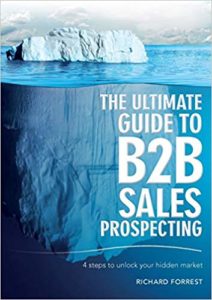I received a call last week from Justin, a marketing director who wanted me to help him grow his company’s sales. It was typical of many such calls I get each year.
So tell me Justin,” I said, “What do you do there at Local Financial?”
“Oh?” said Justin (he seemed surprised by my question). “Um, we provide a unique kind of financial advice and end-to-end relationship solutions to corporate businesses … and things like that.”
He paused, so I asked if he could elaborate.
“Well, as an industry leader, we offer a broad spectrum of products, services and solutions that can be customized to meet a variety of corporate and personal requirements … our team comprises highly seasoned financial services professionals who have the diversity and experience that allows us to offer our customers the highest level of service, advice and responsiveness.”
“Highly seasoned?” I thought to myself (I was starting to feel hungry). I also wondered which of his competitors wouldn’t also claim to have the “highest level of service, advice and responsiveness?”
“Are you a bank?” I asked.
“Not exactly,” Justin replied.
This was going to be a long conversation.
***
Buzzwords, Clichés, Vagueness
I’m astounded by how many people in business are unable to explain, simply and clearly, what they do and how they help their customers. Too many simply regurgitate buzzwords, clichéd phrases and vague, generic pitches. It’s no wonder they can find it difficult to generate enough leads and close enough sales to support their growth targets.
Attracting interest in your product or service begins with an effective elevator pitch – a 30-second to two-minute summary of your business and value proposition.
What are the key components of an elevator pitch?
The key elements are problem, value, credibility, difference and action:
Problem
-
What problem does your product or service solve?
-
What pain is your ideal customer experiencing?
Value
-
How does your product or service deliver value?
-
What are the results in terms of dollars, time or quality?
-
How do you help people or businesses?
Credibility
-
What can you say to demonstrate your ability to deliver value?
-
How can you support your claims?
-
What evidence do you have?
-
How have you delivered value to others?
Difference
-
How is your business, your product or your service different?
-
How is it better than the potential alternatives?
-
What’s your unique selling proposition? (Hint – it can’t be the same thing your competitors promise.)
Action
After you’ve delivered your elevator pitch, the only action you require from the other person is an agreement to continue the conversation, either immediately or at a later date. The best way to achieve this is by offering something rather than asking. Once you give something to someone, in a spirit of real generosity, they’re more likely to open up to continued interaction.
The elevator pitch in practice
Remember Justin? How could he have improved his pitch to explain – simply, clearly and persuasively – why I should be interested in his business?
Here’s what he might have said:
-
People and businesses often lack the capital to turn their goals and dreams into a reality. [Problem]
-
At Local Financial, we help people get the money they need to grow and prosper. We help them source the right amount of money for their needs – in record time, at the lowest cost, and with minimal red tape. [Value]
-
In fact, Local recently helped Meridian, a company much like yours, to raise $5 million to expand their business into South East Asia. [Credibility]
-
Susan Lee, Meridian’s CEO, told me that working with Local was easier and faster than dealing with a bank. She said our interest rates were extremely competitive and the repayment terms were more flexible. [Difference]
-
I’ve actually written a short case study on the Meridian deal. Can I send this to you? [Action]
Of course, you can use different parts of this pitch at different times and change the action to suit the situation. You should always be prepared to do so.
It’s not about regurgitating a script verbatim. It’s about having a clear, concise message in your mind that you can draw on and adapt to the person you’re speaking with – to communicate how you can help them and why they should engage with you further.
What’s your elevator pitch?
Here’s a list of questions to ask yourself as you tackle your own elevator speech:
-
Does my pitch articulate a core problem that our product or service solves?
-
Am I explaining, in simple language, how our product or service delivers value?
-
Am I including examples to show how we’ve delivered value to others?
-
Am I presenting a clear USP (unique selling proposition) that includes how we are different from our competitors?
-
When I’m finished presenting, is there an incentive for my prospect to continue the conversation with me?
Once you have satisfactorily answered these questions, you can use your pitch at networking events, during proactive outbound calls, adapt it for your website and social media channels, expand it for a corporate brochure, or use it in a footnote at the bottom of any articles you write.
You never know, one day you may even meet a prospect in an elevator and you can use it then.





